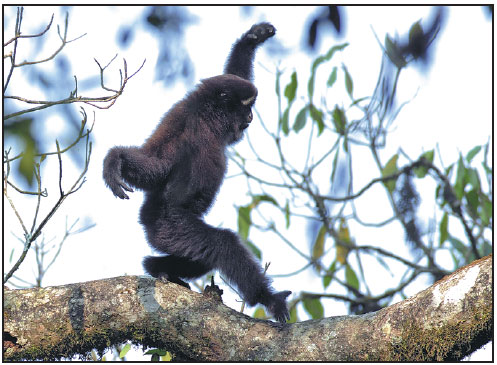New species of ape announced
Calls have been made for the gibbon to be classified as an endangered animal
Chinese scientists announced on Thursday in Kunming, Yunnan province, that less than 200 hoolock gibbons distributed in the province are actually an entirely new species, known as the Gaoligong hoolock gibbon (Hoolock tianxing).
In the past few years, two subspecies of hoolocks have been reclassified as species of their own - Western hoolock gibbons and Eastern hoolock gibbons. The newly announced species was originally considered an isolated population of Eastern hoolock gibbons.
As the first ape species ever named by Chinese scientists, tianxing, which means "heaven's movement" or "skywalking" in Chinese, are also known as Skywalker hoolock gibbons.

An international team of scientists led by Fan Pengfei, one of China's leading primatologists from Sun Yat-sen University in Guangzhou, Guangdong province, identified the new species and announced their discovery in a paper published on Wednesday in the American Journal of Primatology, a monthly peer-reviewed science journal.
In 2007, Fan and his colleagues began studying Eastern hoolock gibbons. Between 2008 and 2009, they conducted a comprehensive survey in Yunnan province and began regularly monitoring three hoolock populations, accumulating a large number of photos of the ape.
"Studying the photos closely, I found that gibbons in China don't have white beards or white fur around their eyes, and they have thin eyebrows with a wider space between them," Fan said. "Male Skywalker hoolocks have black or brown fur in their pubic region. Their features are different to Eastern hoolocks."
According to Fan, all hoolock gibbons have white eyebrows and some have white beards, but Skywalker hoolocks have distinctive downturned brows that stand out against the black fur on their head.
In 2010, Fan made a research plan and invited more scientists to join the project. A comprehensive study of the genetic characteristics of wild gibbons and museum specimens, and assessment of coat color patterns and tooth morphology followed.
Finally, 15 members of the research team concluded that the population of hoolocks distributed to the east of the Irrawaddy and Nmai Hka rivers are actually morphologically and genetically different to Eastern hoolock gibbons distributed west of the rivers, and are a new ape.
According to Jiang Xuelong, a professor at the Chinese Academy of Sciences' Kunming Institute of Zoology and co-author of the paper, Skywalker hoolocks are scattered in fragmented forests in the Gaoligong Mountains in Bao-shan, Tengchong county and Yingjiang county. They are distributed at between 500 meters and 2,700 meters above sea level.
With a population in China of less than 200 and an unknown population in Myanmar, which is "probably much smaller because of limited distribution areas", Jiang said that the team has called for the International Union for Conservation of Nature and Natural Resources to classify gibbons as endangered.
"In the past 20 years, the gibbon disappeared from several of its historical distributing areas in Yunnan," Jiang said. "Fortunately, half of the present population are living within the Gaoligong National Nature Reserve, where they have already been put under better protection."
|
A white-browed gibbon lives in the Gaoligong National Nature Reserve in Southwest China's Yunnan province.Zhao Chao / For China Daily |

















